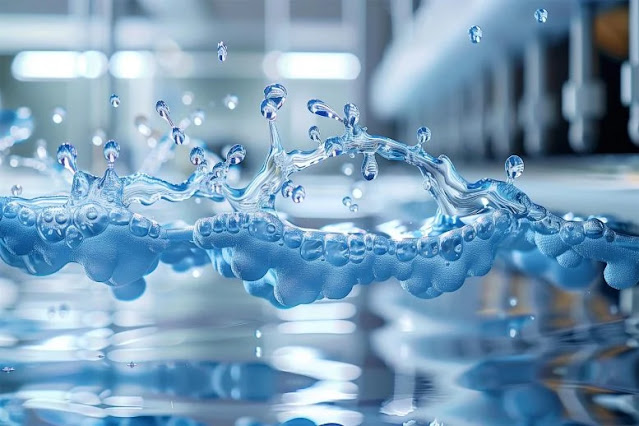Research on metal-organic frameworks has led to the development of superhydrophobic surfaces by grafting hydrocarbon chains, which create a high-entropy state essential for minimizing water adhesion. (Artist’s concept.)
Credit: SciTechDaily.com
New materials with near-perfect water repellency offer potential for self-cleaning surfaces in cars and buildings.
Scientists from Karlsruhe Institute of Technology (KIT) and the Indian Institute of Technology Guwahati (IITG) have developed a surface material that repels water droplets almost completely. Using an entirely innovative process, they changed metal-organic frameworks (MOFs) – artificially designed materials with novel properties – by grafting hydrocarbon chains. The resulting superhydrophobic (extremely water-repellent) properties are interesting for use as self-cleaning surfaces that need to be robust against environmental influences, such as on automobiles or in architecture. The study was published in the Materials Horizons journal.
Superhydrophobic Surfaces from MOFs
Metal-organic frameworks (MOFs) are made of metal ions connected by organic linkers, forming a porous, sponge-like structure. Their remarkable surface area — just two grams can cover the size of a football field — makes them valuable for applications like gas storage, carbon dioxide separation, and advanced medical technologies.
Beyond their internal pores, the outer surfaces of MOFs also offer unique properties. Researchers enhanced these surfaces by grafting hydrocarbon chains onto thin MOF films, creating a water-repellent material with a contact angle of over 160 degrees. A higher contact angle means better hydrophobicity, as water droplets form a nearly spherical shape instead of spreading out.
“With our method, we are able to achieve superhydrophobic surfaces with contact angles that are significantly higher than those of other smooth surfaces and coatings,” explains Professor Christof Wöll from KIT’s Institute of Functional Interfaces. “Although the wetting properties of MOF powder particles have been explored before, the use of monolithic MOF thin films for this purpose is a groundbreaking concept.”
Left: Porous substrate with a small water contact angle: The surface absorbs a lot of liquid.
Right: The new material features a large water contact angle and is thus nearly completely hydrophobic.
Credit: KIT
The team attributes these results to the brush-like arrangement (polymer brushes) of the hydrocarbon chains on the MOFs. After being grafted to the MOF materials, they tend to form “coils” – a state of disorder that scientists call “high-entropy state,” which is essential for its hydrophobic properties. The scientists asserted that this state of the grafted hydrocarbon chains could not be observed on other materials.
It is remarkable that the water contact angle did not increase even when they used perfluorinated hydrocarbon chains for grafting, i.e. substituting hydrogen atoms with fluorine. In materials such as Teflon, perfluorination brings about superhydrophobic properties. In the newly developed material, however, it decreased the water contact angle significantly, as the team found out. Further analyses in computer simulations confirmed that the perfluorinated molecules – in contrast to hydrocarbon chains – could not assume the energetically favorable high-entropy state.
Insights from Surface Roughness and Theoretical Analysis
In addition, the scientists varied the surface roughness of their SAM@SURMOF systems in the nanometer range, thereby further reducing the water adhesion strength. Even with extremely small inclination angles, water droplets started rolling off, and their hydrophobic and self-cleaning properties were significantly improved.
“Our work also includes a detailed theoretical analysis, which links the unexpected behavior shown in experiments to the high-entropy state of the molecules grafted to the MOF films,” says Professor Uttam Manna from IITG’s Chemistry department. “This study will change the design and production of next-generation materials with optimum hydrophobic properties.”
Recommend this post and follow
The birth of modern Man



No comments:
Post a Comment
Stick to the subject, NO religion, or Party politics